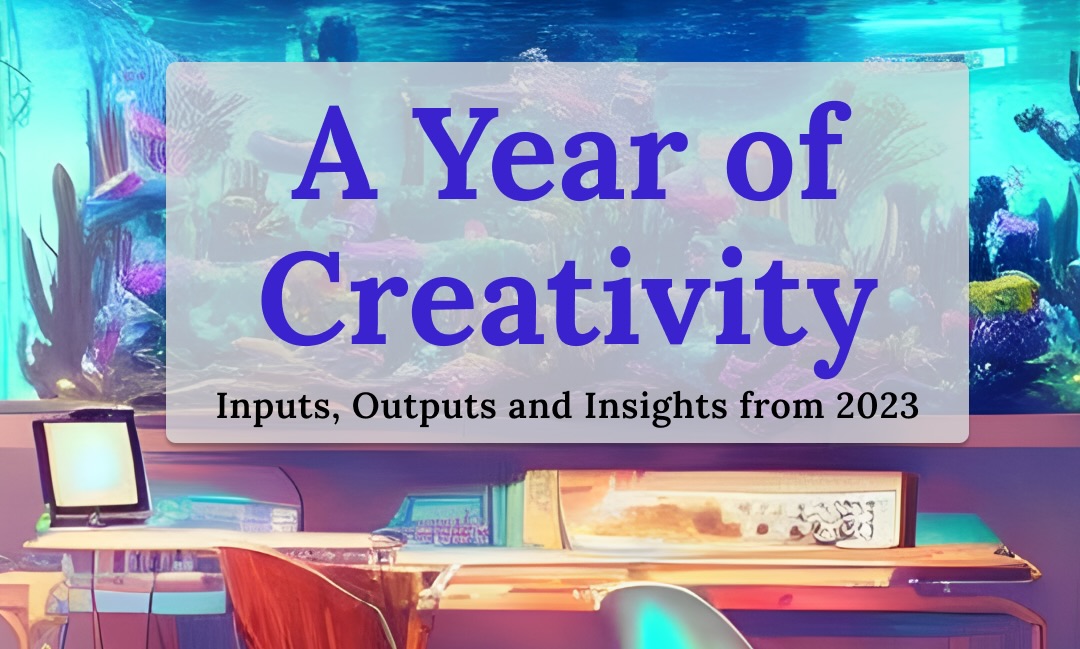How do our actions become our creations? Which of our creative inputs will add up and eventually translate into our creative outcomes? What does it take to be creatively productive?
As a creative it’s very difficult for me or anyone to know what steps add up to our final creative output. The journey from idea to creative output varies each time. We should strive to show up daily, take regular progress-building actions and aim at tangible artistic creations, but what matters most between the start and end on a creative project?
As learners it’s challenging to navigate our learning paths. What are the most beneficial actions towards the skills we host to acquire or topics we master? How do the classes we take, the books and articles we read (and notes we take) eventually turn into a paper we write or an area of expertise?
As a writer, music producer and business builder, I’d like to know more about my own creative journeys. For over a decade I’ve tracked my time and tasks as well as a host of other quantified self metrics. As you can see from my most recent year in time, I largely know where my time goes down to the minute and what tasks and projects I am working on any given day or week.
But how do my time input and completed tasks transform into tangible outputs such as words, notes, writings and eventually publications?
In an attempt to answer (or least bring data to this question), for the past four years (2019-2023), I’ve also been tracking my words, writings and note-taking. I’ll provide more details about my tracking setup in the following section, but in summary, it’s a two-part system. First, I track my keystrokes in terms of creative typed word count, and, second, I log my digital writings with a tool used by software developers to manage code (Git). Together I track a certain behavior along with a certain output.
As of the time of writing, I have 6081 documents encompassing my writings, notes, reflections, and more. For nearly all of my personal writings, journals, smart notes, and my private project notes, I have individual plaintext files and a log of changes made on those files. All of my notes are digitized, allowing me to monitor my written creativity over time.
So, how does my time, learnings, typed words and note-taking translate into become outputs like blog posts, songs released and written content? What role do my readings, note-taking, studies, journals, and writings play in what I end up creating? What threads started were never finished?
In this post, I aim to delve into how I track my creativity and what insights it may offer regarding the transition from creative inputs to outputs and eventual outcomes. Specifically my goal is to look at my last year (2023) from the perspective of my tracking of creative outputs and inputs.
After providing a brief overview of how I track my notes and writings, I’ll look at some data on my outcomes, namely blog posts published and music released. I’ll present highlights and charts that delve into various key creative inputs, such as studies, journaling, typed word counts, and the Git changelog of notes and writings. We will then conclude by looking at the connection between outcomes and inputs and some initial answers into how creative inputs turn into creative ouputs. I’ll also speculate on the future of tracked and AI augmented creativity with Large Language Models (LLMs) like ChatGPT and where I see this going for me (and others in the future).
How to track your creativity? How I Quantify My Typed Words, Notes, and Writings
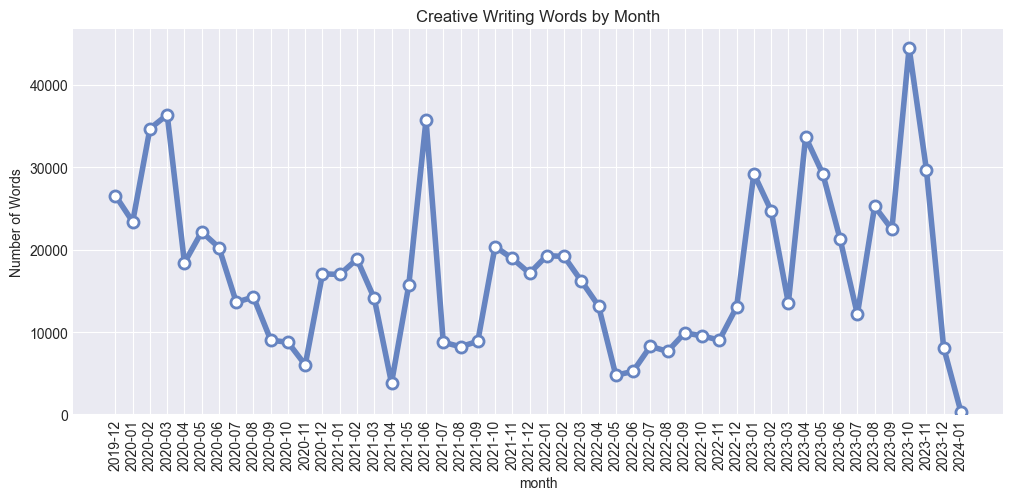
Is it even possible to track one’s creativity?
As someone who has strived to track and visualize nearly everything from my health, exercise, and time to my reading and completed tasks, I’ve struggled to effectively quantify and track my creativity.
It’s easy to track our outputs (as I’ll show below). It’s also fairly easy to track our time and even tasks. Unfortunately, even though it’s clear from the science of flow that the mental state of flow is crucial for creativity and peak performance, our options for tracking flow are mostly limited to manual logging, which can disrupt the flow.
Fortunately, as I explain in detail in Tracking Your Writings and Note-Taking we can track our written words in two ways. First, using a wordcounter tool we can track how many typed words we input per hour and daily. Second, with a plain text file system, we log and monitor changes to any documents and files we add or edit over time.
For several years, I’ve been utilizing a note-taking and knowledge management system I refer to as the Plaintext Life. It involves taking notes and writing using plain-text files. I use links, tags and simple naming conventions to keep my notes organized, quick to find and interconnected. Combined with other task management and self-tracking, it has effectively become my second brain and a key support in my learning creative journey.
Here are the core sources of my creativity tracking:
Inputs / Actions:
- Journal Entries
- Daily Typed Word Counts (and what program used) - tracked using a word counter app that logs number of key strokes per hour
- Daily File Changes - For example, I use a git based file tracking system that lets me look at changes on project notes, pieces of writing, and my learning or study notes.
- Time - I manually track my time on writing or design work and also use an automatic computer usage tracker
Outputs / Outcomes:
- Newsletter Published
- Blog Posts Published
- Album / Songs Released
At present, this side of my tracking approach is largely a quantitative perspective that delivers statistics and charts. I believe it offers a good beginning for tracking my creativity.
Hopefully over time with ChatGPT and other AI tools as well as additional coding and data analysis, it might offer an incredible starting position for augmented creativity tracking. For example, I plan to add code to summarize my daily text changes and assign some categorizations. This could then become a much richer source for looking at trends over time and see how studies becomes notes, notes turns into journal entries and drafts, and all of this transforms into some kind of outcome. This endeavor extends beyond the scope of this particular post, but I look forward to sharing an update in the coming months.
Ok, now that we’ve looked high-level on how I track my creativity, let me next share the highlights of my creative outcomes from the last year.
My Creative Output
Key Highlights and Creative Outcomes
Before I attempt to tease out my creative inputs, what were my major creative outcomes?
Blogs and Newsletters Published
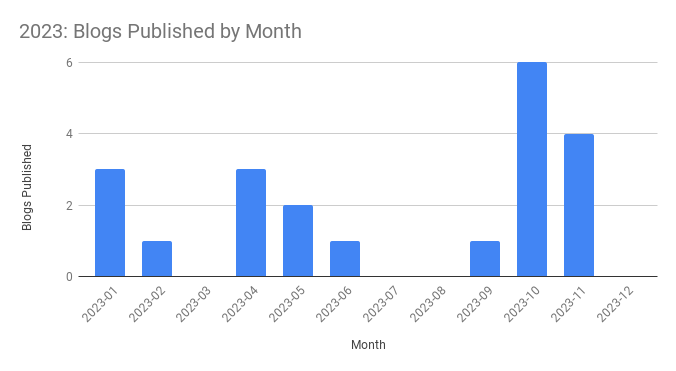
In 2023, I published 21 blog posts and 2 newsletters. One of my stated goals for the last year was to achieve More Regular and More Abundant Creative Writing, and I’m delighted to report that I succeeded.
While I had four months where I had no publications, I did manage to publish on average 2 blogs per month with my best period coming in October (6 posts) and November (4).
How do I track my published writings?: I maintain a straightforward spreadsheet that I update manually. In the past, I employed an IFTTT integration with RSS feed to automatically add a row to the spreadsheet upon publication.
Below is a breakdown of my blog posts by topic:
- 4 posts on music production and creativity
- 3 book reviews / book notes, specifically on authenticity
- 2 “year in data” posts: Book Reading and Time
- 2 album releases: Symbolic Wonderlands and Cosmic Coastlines
- 2 personal reviews / goals: Annual Review and 40 Years Young
- 2 posts on AI and reflection/journaling - AI as a Journaling Companion and Stop asking AI for answers and start asking it for questions.
- 2 posts on growth hacking and digital marketing (Data-Driven Dashboards for Traction and Growth Hacking Deck).
- 1 post on self-tracking / quantified self: Time Tracking: Ultimate Guide to How to Track Your Time and Life
- 1 case study on building an AR app for tracking attention
- 1 post on note-taking and project management entitled The Power of Project Notes
- 1 philosophical treatise on communitarian choice
Writing has a lot of benefits. I continue to find that writing, whether for a professional step or a creative project, tends to help me move forward. Journaling has become a key component in starting my day strong, capturing memories or processing certain internal debates and intersocial challenges.
Writing is also a strong part of how I learn and think through design and product ideas. It is also where I externalize my learnings and share my approach to life and technologies.
Writing can help you find a community and tribe. As I near almost 20 years blogging, I am continually amazed at the response to the small group of topics I focus on writing on, building for and reflecting on. I don’t get thousands of comments or emails, but those that do are very much aligned with the ideas I share and world I’m building through ideas and digital products. Writing, in short, has been a launching pad for finding well-aligned clients, partners, collaborators and friends.
Music Released
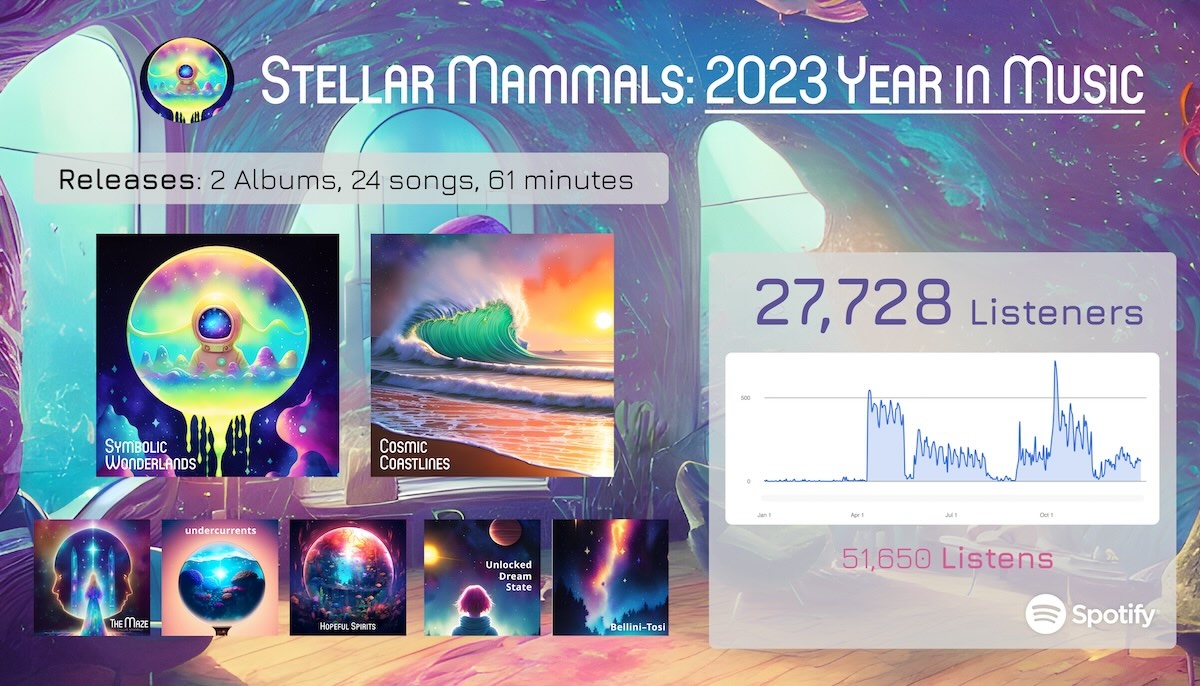
Album covers and Spotify listens in 2023
I release music under the stage name of Stellar Mammals.
One of the yearly goals I set for myself last year was to Keep Writing and Producing Music. In retrospect, I exceeded my expectations in terms of my music creation and production goals.
In 2023, I finished and released a total of 24 songs on Spotify, Apple Music, Amazon Music, and seeral other music streaming platforms using DistroKid.
This included several singles and two albums, namely:
- Symbolic Wonderlands - 14 tracks (38 minutes).
- Cosmic Coastlines - 10 tracks (23 minutes)
Additionally, I created two music videos or “music visualizers” using images and animated video clips generated with the help of AI technologies such as StarryAI, Midjourney, and RunwayML.
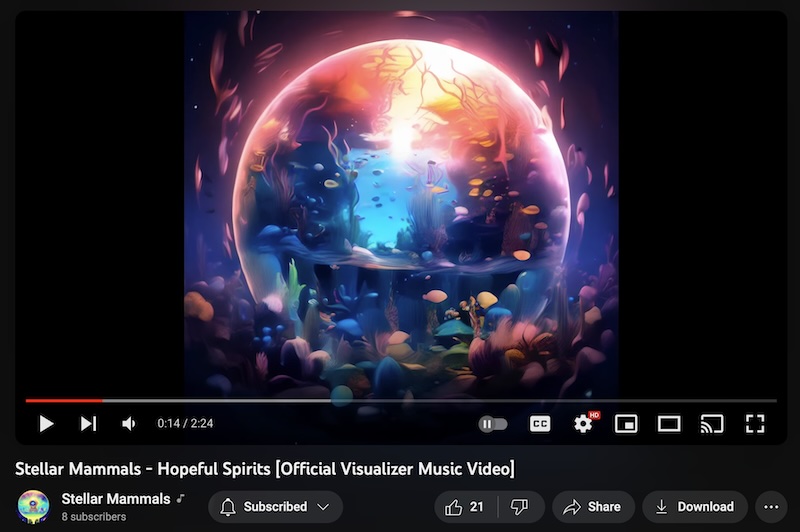
Watch on YouTube: Hopeful Spirits by Stellar Mamamls
Furthermore, I generated approximately 30 short-form videos or “canvas” that appear when playing any of my songs on Spotify.
As artist it’s a joy to simply create art regularly. However, I also acknowledge the importance of growth and marketing. Along with improving my music production skills and releasing music, I used a few different promotional and marketing strategies find and grow new listeners to my music. For example, on Spotify under my artist name of Stellar Mammals, I had 27 thousand listeners and a total of 51,650 streams or listens over the year, and my songs were saved 236 times and had 977 playlist adds on Spotify alone. It’s incredible to have my music in so many ears!
What I Learned?
My Studies and Learning in 2023
In my 2022 annual review, I had set an intention to go beyond just reading and strive to Externalize My Learnings. The key point is to take what you read and try to explain it yourself, at least through a journal entry, reflection, or some personal notes. Even better, though, is to write and share a blog post on a topic or idea. Last year several of my blog posts were largely centered on externalizing my professional learnings on growth hacking and music production.
I consider life-long learner to be one of my core identities. I strive to read daily, and at the end of each year, I know that a part of my personal growth came from the incredible ideas I’ve gained and cultivated from the books I read and online courses I’ve taken.
But how to track what we read and learn? And even more important how do the things we learn connect with what create and decisions we make?
Unfortunately, outside of school, quantifying and tracking a year in learning can be challenging. Personally I do three explicit activities to track my readings and learnings.
-
First, I log my reading with Goodreads. This gives me a list of all the books I read and some fun factoids. According to my year-in-reading, I read a total of 79 books, covering 21,527 pages.
- Second, since I mostly read on my Kindle, I use an open source project I created called QS Ledger to collect my kindle highlights and create a bunch of data visualization charts. This then allows me to see an aggreate my year in read through book highlights and clippings. According to my logs, I collected 4,433 book highlights in 2023.
- The third way I “track” my learnings is with a simple document I titled “My Studies: Meta-Note on Things I Am (and Want) to Study.” About every 4 to 6 weeks I spend a few minutes noting key topics I’ve been learning and reflect on what I want to read and learn next. The key result is a list show topics or books I’ve read month to month.
Here’s a chart displaying my monthly book highlights:
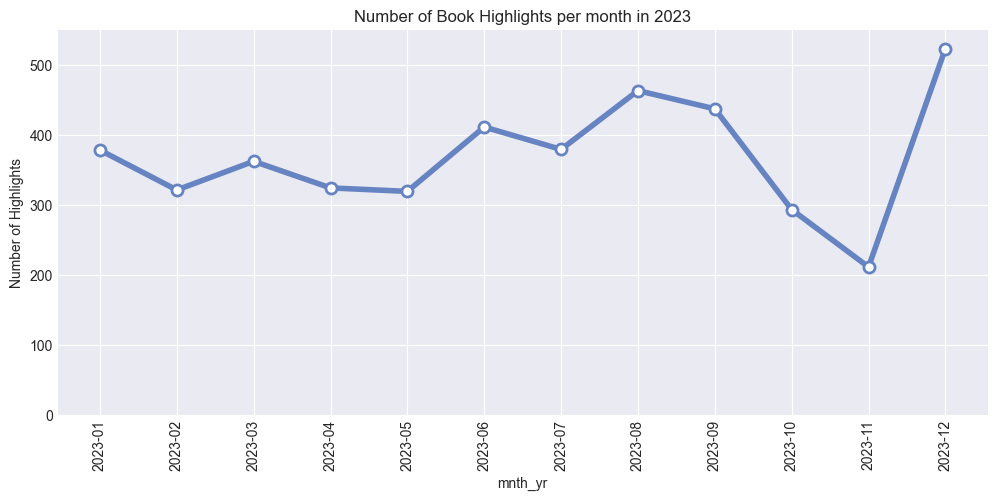
If you are interested in seeing more data on book reading, check out my 2023 year in reading for a detailed example.
Here is what I learned in 2023:
- Jan: Panama Canal Construction History, BOOK: Breaking the Age Code
- Feb: BOOK: Existential Physics, Belize/Guatamala, Maya, Maya Script
- March: Central America, BOOK: River of Doubt, BOOK: Through Language Glass,
- April: [🎶Finished 2nd Album!] Hearing/Tinnitus, Mastering, Creativity, Music Flow, Creative, Organization, Music Promotion, Goals, BOOK: Theory of Society, Learning Paths, Microphones, Recording Vocals and Guitars,
- May: Goals, Songwriting, Vocals, Jazz Drums + Brass, Systems Theory, Emei Shan, Daoism / Qingchengshan, Fantasy Novel Writing
- June: Album Production, Brass/Trumpet, Daoism / Qingchengshan, Fantasy Novel Writing, Creativity, Guitar
- July: Daoism, Creativity, Geology - esp Sierra Nevada, BOOK: Art of Impossible
- August: Geology, Authenticity, Mixing (in Music Production), Matching Theory in Economics, Brian Eno Biography, Hearing Loss, Fifty Bits Design, Goals
- September: [🎶Released 3rd Album!] Hearing Loss, Philosophical Perspectives on Human Nature, Video Creation inc AI Video Generation, Video Editing with DaVinci Resolve, Filmmaking
- October: Human Nature, On Writing, Growth Hacking, Cognitive Errors, Flutter (for Mobile Dev), Authenticity
- November: Authenticity, Flutter (for Mobile Dev), Human Nature, Writing, BOOK: Artist Rituals
- December: Sound Synthesis (Music), Memetic Desire, Mayan, Cenotes, BOOK: Outlive
As a life-long learner and as you can see from this list, my studies in a year can span history and science to technology and advanced algorithms and dozens of topics in-between. I’m a software designer and engineering so I spend a few periods per year exploring new technical topics and improving my skills.
While ChatGPT serves many purposes, for me one key aspect is for learning and ideation. In How are you using ChatGPT?: How I Track and Reflect on my AI usage with Quantified ChatGPT, I shared some initial ChatGPT tracking and analysis code I’ve developed and charts and data on my year in ChatGPT usage. I am excited to see how my usage evolves and how I might use ChatGPT to fill various gaps in how I learn, journal and ultimately think.
Creative Inputs:
Journaling, Words Typed, Files, Notes and Creative Time
Now that I’ve summarized the highlights of my creative outcomes and looked into some of what I learned, it’s time to try and tease out what I believe were key creative inputs.
The obvious question is: What activities do I think had or have the most meaningful impact on creativity and creation? Personally, I believe in (and think I have some data to back up) the positive impact of journaling, word count, note-taking and focused creation time (either for writing or music).
Let’s look at these one by one, before exploring the connections between inputs and outcomes in the next section.
Journaling: How many journal entries did I do?
I’ve long believed that journaling could have a positive impact on my creativity, focus and well-being. Following a decrease in journaling (along with blogging), I had a really solid return to regular journaling last year. In 2023, I wrote 167 digital journal entries, which I fondly refer to as “morning pages.”
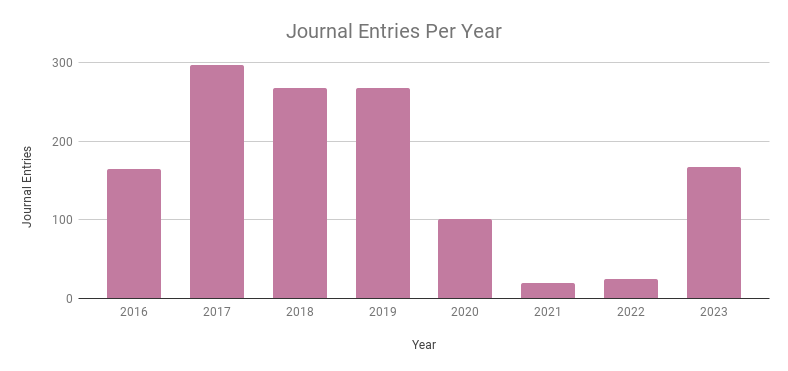
I also took a significant number of physical notes. While mostly dedicated to notes on books I read, I managed to fill three and half physical journals last year or about 375 paper notebook pages. This largely served as an extension of my reading and learning habits. Physical notes aid in my learning as I read and provide a good starting point for smart notes and journaling as well.
Words Typed: How many words did I type and using which programs?
Assuming that the physical act of writing or typing contributes meaningfully to creativity, especially writing, then a log of keystrokes becomes a proxy for tracking aspects of creativity.
For the last several years I’ve used a Mac application called WordCounter that logs my keystokes and what programs I was typing in. I’ve configured it to ignore browser typing and a few other programs and track keystrokes on my note-taking and writing tools. It then generates an hourly log of typed words.
In 2023, I averaged 979.7 typed creative or note-taking words per day. My best day per week was Mondays and my highest day of typed words was 6,492. In comparison, in 2022 I averaged just 497.3 written words per day.
With the help of data analysis code, I can generate logs and charts depicting how I typed ‘creatively’ over time.
For example, here is a heatmap comparing daily words per day in 2023 vs 2022:


Although Wordcounter and my typed word logs can’t reveal the specific words I was typing, I believe that the act of creative typing serves as a leading indicator of creative productivity.
One interesting aspect is examining the programs I used over time. In my case, I largely use Typora for mostly project note-taking and The Archive for study notes, journaling and creative writing.
Here are a few charts showing program usage over time:
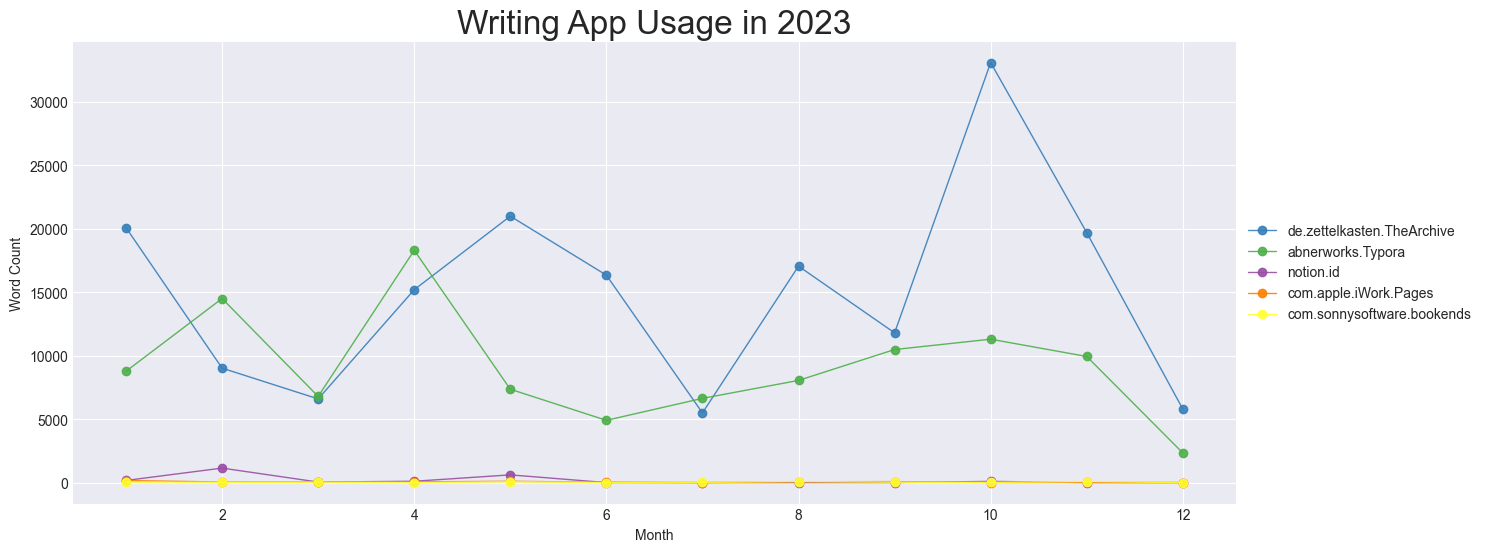
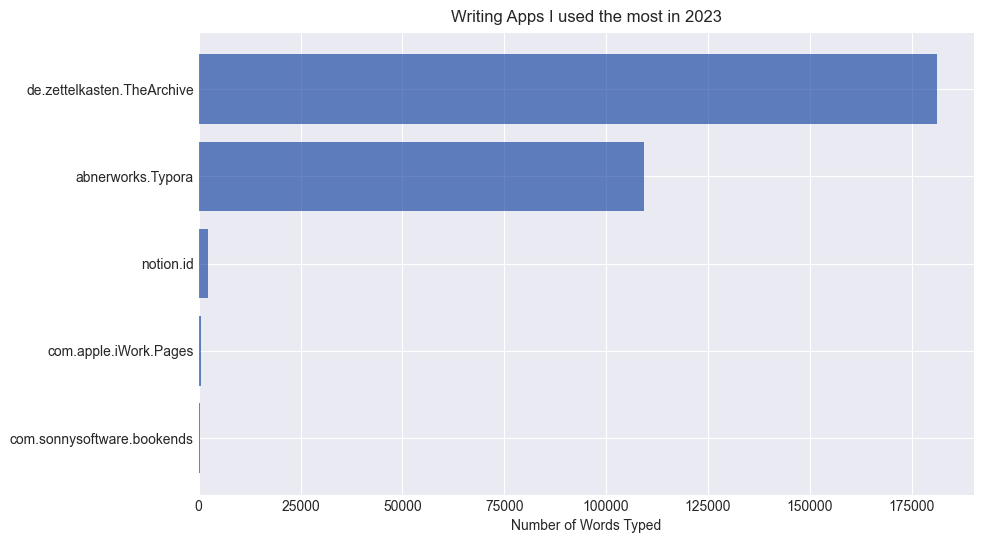
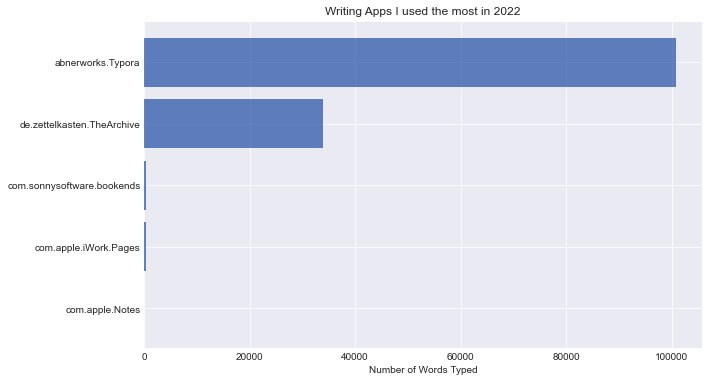
Although this isn’t a perfect method for distinguishing between project notes and smart notes or creative writing, the annual data does demonstrate that I shifted more towards creative writing, learning notes, and journaling last year, as opposed to primarily focusing on project note-taking.
Time Input: How much time did I spent on creativity, like writing or music?
Stats on hourly and daily typed word counts are a good behavioral indicator of being creatively productive. Unfortunately besides a breakdown on which program I inputted words on, there is much else I can glean from this data. Another behavioral indicator I can utilize, one that offers more specificity, is my time tracking logs.
NOTE: A full data-driven dive into my 2023 year in time is outside the scope of this post, and I recommend you check out this dedicated post: A Year in Time: 2023.
Where you invest your time plays a significant role in determining the creative outcomes you will achieve. Time input also key to learning too. You just can’t make progress without focus and deep work on your creative works.
To align my time input with my key creative goals, I strongly advocate for the importance of time tracking. I have been a dedicated time tracking for many years. I have several years of time data related to creative writing. As my music hobby turned into a professional pursuit, I also have detailed music production time logs too.
Creative Written Time: 208 hours

In 2023, I put in a total of 208 hours on my creative writing. This includes nearly 19 hours on journaling.
Several of the bigger time blocks are associated with some of my bigger writing projects:
- Journaling: 18:45:00
- Music Production Journey: 11:29:25
- Authenticity Book Reviews: 11:08:56
- Tangible Artistic Creations: 07:40:25
- AI as a Journaling Companion: 07:37:50
One of the main takeaway from the time logs is that several of my blog posts took over 7 hours each to research, draft, edit and finish. Put another way, good writing takes a good amount of time. There are ways to write more effeciently, but it’s pretty hard to completely eliminate the time commitment to a serious writing.
I can’t underestimate that a good piece of writing often times takes days and weeks rather than hours. Unlike music, where the target is 2 to 5 minutes of listening time, good writing takes longer to complete.
Music Time: 267 hours

In 2023, I dedicated a total of 267 hours on my music and music learning and practice in general. Ironically, even though I released 18 more songs last year than year before (24 in 2023 vs. 6 in 2022), I actually put in 46 fewer hours music time in 2023 than 2022. There are several reasons for this.
During my first EP release, I was still in the process of acquiring many skills. I wasn’t sure what genre to focus on either, so some of my song writing ended up not fitting with the eventual project I released under. Additionally, I have become progressively more focus on making music, rather than learning about music making. I think learning is important, but when it comes to music, it nearly always best to learn by doing over concepts.
Looking at my heatmap of daily music time, it’s clear that there was a lot of variance. I had a few really strong periods like January, April, May, June and November. As an artist, I have various interests that pull me. Professionally I have times when I’m less available than others. This means that my time input varies throughout the year.
It’s also possible that I experienced periods of creative indecision. These are times when you struggle to take progress-building actions as often as you should. Creative projects are hard in different ways at different moments. I need to embrace these different “seasons” for my creative projects and ensure I have the right reflections and support tools depending on if I’m in exploratory new song writing mode or if I’m in the end game of polishing and finishing.
Interestingly, my top music time activities maps well to varying phases and priorities:
- Music Production Jamming: 52 hours and 48 minutes
- Album Production - Reworking: 20 hours and 1 minute
- Album Production Work: 18 hours and 3 minutes
The amazing idea from a time perspective is that this 90 hours slice of time carries some of the most important creative outputs since jamming is where I start new songs and reworking is when I’m finishing.
One question to consider is whether I can find a way to prompt myself to reconsider or think twice about how I allocate my time and music focus, ensuring it aligns appropriately with the current creative stage of a project. Is what I’m focused on and doing right fitting for my specific creative challenge or the current stage of the project?
Files Changes: What files, notes and drafts am I editing and adding to?
The final aspect related to how I might track my creativity are the actual changes on the files and documents I write and edit. Since I write in plaintext files and have a script to monitor daily changes on my files, there is a signficant amount data to look at.
My specific approach to writing and note-taking means that I effectively have a daily commit and a changelog for nearly piece of journaling or writing I do. As of the time of writing, I currently have 6,081 notes–1,230 project notes and weekly reviews and 4,851 smart notes, journal entries and personal writings. Excluding notes before 2018, I have a digital record for any changes I’ve made on these notes over time and an aggregated stats of daily changes, like new notes, files modified and images added. My digital archive and second brain has a history. This data can tell both a quantitative story and a qualitative one too.
Here is a snapshot of me adding journal entries, study notes and writing drafts:
![]()
Since I split my documents between 1.) my project notes and weekly reviews and 2.) my writing and study notes, we can look at a side-by-side comparison of writing for projects and writings for myself:
![]()
![]()
At first glance, it’s interesting to see that project files tend to get additions early in the week, like Sunday to Wednesday, while writing, journaling and study notes are pretty evenly spread out day to day.
While these trends are interesting look into behavioral patterns, it still doesn’t tell me much about what I am actually doing or provide much of indicator about which documents are changing or what words I’m adding or editing. It tells me nothing about the specific study notes and word changes, leading to a blog post.
Since my changes over time are logged into Git, there is a big opportunity to try and lokk at diff’s over time using an AI assistant like ChatGPT to summarize daily changes and potentially paint a picture of qualitative changes I’m making. I’m excited to share a future update probing these changes over time with AI tools and data analysis. Hopefully it can help me see what I’m learning in new ways and provide opportunities to explore missing topics or write-up key links between disparate ideas.
Conclusion: From Creative Inputs to Creative Outcomes and What’s Ahead
Assuming one could pool together one’s key knowledge artifacts–like journal entries, project notes, blog writings, strategy docs, learning notes, and other note-taking, what story would those tell us? What if we could combine it with behavioral analytics (time tracking and word count)? What could we learn about our learning and creating over time?
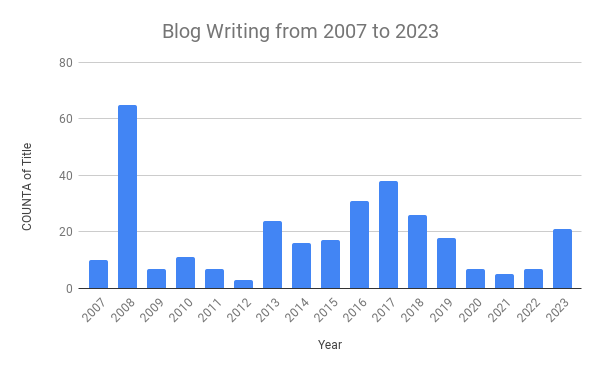
Excluding my most fruitful writing period in 2008 (spanning leaving France, travels across the United States and moving to China), my most productive blog writing and publishing period was between 2013 and 2019. Four years ago I wrote a post entitled A Year in Writing and Creating: 2019 where I explored my tracked creativity, mostly my writings.
Unfortunately, my return to the United States between 2020 and 2022 represented a big dip in my writing output. I wasn’t writing as much nor publishing blog posts. One my big intentions for 2023 was to write more as well as create more music. In looking at my last year (2023) in creativity, I’m happy to stay that I was successful in increasing my creative output in terms of writing and music.
In 2023, I wrote and released 24 songs, along with publishing 21 blog posts and 2 newsletters.
There were several key creative input changes that I think contributed to this increased creative output. Specifically, I journalled more, I typed creatively more often and with great frequency, and I put in time into two of my main creative endevours, writing (208 hours) and music (267 hours). My notes and knowledge management system grew signficantly too, as I looked to writing, reflection and journaling as a key link between creative ambiguity and next steps.
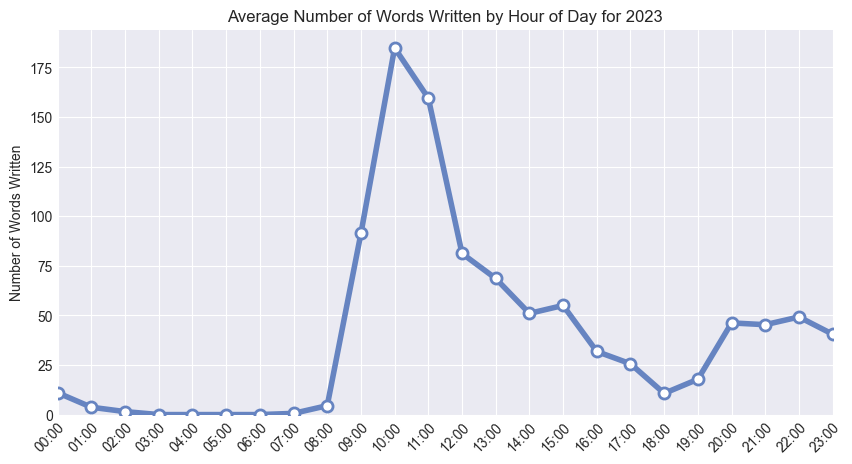
Put another way, we see several creative inputs (journaling, time and showing up and typing) as key indicators towards tangible creative outputs. In terms of philosophy of productivity, it shows how important incrementalism or the patient pursuit of regular progress-making steps is towards a goal or objective.
While this qualitative data story on my creativity is interesting and provided a great chance for exploratory data visualization, I still see a few major gaps and opportunities ahead.
What are the correlations (or not) between different creative inputs and outputs?
In this post we looked at each of these data streams separately and reported on them at a high level. I see early evidence and support for certain practices I do like journaling and dedicated time as key to creative progress. But at present the data was looked at separately. It would be interesting to work at combining all of this data and additional metrics on sleep and exercise and explore possible correlations. For example, what role does journaling have on my music? How do typed words contribute to word changes in projects vs creative writing? All of these questions become explorable in a combined data set.
How Might Data Science Tooling, AI, LLMs and other change how we track and augment our creativity?
With the increasing digitalization of our creative tools and processes, it’s more and more possible to point to documents and digital footprints underlying our work. These repositories of our creative writing and knowledge learning seem like prime examples for positioning a large language model AI agent, like ChatGPT. I believe I can already apply some of these tools and even additional data analysis to my own file directories and git note repositories to attempt to better track topical changes over time.
On one level, it would be interesting to see a more qualitative data story on my creativity and leverage an LLM to articulate a portrait of my writings and learnings over time. This could offer a fresh perspective on self-awareness, offer coaching to maintain a writing streak, or explore journaling topics based on past interests.
On another level, this is just scratching the surface on what might be one possible future of tracked and AI augmented creativity. For example, by building a knowledge graph of my notes, an LLM agent might be able to help connect ideas I’m writing with past notes and writings I may have forgotten. It might even nudge me to see gaps I hadn’t noticed or to look into topics and books to consider.
As a knowledge worker, builder and creative, it’s not obvious what’s ahead for us. It sometimes feels like automation and AI will replace us, but I personally don’t think AI alone carries as much weight as we fear. It doesn’t (yet) have the interests, inclinations and visioning that comes from us humans. AI is largely a tool and shouldn’t be framed as a being, consciousness or agent just yet.
For the time, we should be optimistic and design orienting in thinking about and building a relationship of co-creation with AI. Data can already help me see how creative inputs take us towards creative outcomes. Soon AI might help me see real connections connections between outcomes and inputs, grow my knowledge over time and articulate and express myself with AI together.
How could AI empower us to gain insights into our creative journeys over time?
Much of knowledge work (whether for a job or as a student) is text-based. For example, each day we write emails, update documents, code, and send chat messages. Even if our output isn’t always textual, our written words provides many of key threads that get weaved together into the tapestries we create and deliver through our creative work, personal development and learnings.
Our technology usage, data trails and AI might one day soon enable us to take a pretty incredible next step in the science and art of learning and creating.
Check out other posts, data visualizations and infographics from my year in data!
AIDA (AI Disclosure Acknowledgement): The following written content was written by me with the assistance of an AI-based system (ChatGPT). Specifically I used it to help me in some aspects of the pre-writing ideation as well as for final copywriting.

